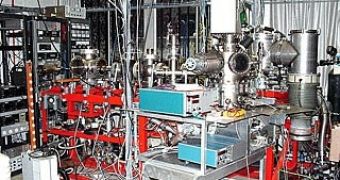The following few years could bring us a ground-shaking new atomic microscope based on the fantastically smooth mirror just developed by the scientists from the Surface Science Laboratory at Universidad Autonoma de Madrid. While this new device type would not provide a much higher resolution than the currently-used electron microscope, it will still be free of the many issues that the latter has.
The surface of the mirror looks like a curved wafer. The mirror is made from a thin (50 microns) crystal of silicon which lies under an even finer (1 or 2 nanometers-thick) layer of lead, and it is capable of reflecting up to 67% of the atoms of helium that come in contact with it, as opposed to just 1% which represents the result of the previous attempts to create such an item. The lead layer is poured at temperatures of 114 degrees Kelvin (-159 degrees Celsius or about -255 degrees Fahrenheit), which makes the surface form in a smooth way due to quantum stabilizing features and maintain its smoothness as the temperatures return to normal.
Based on the newly-developed mirror, the atom microscopes would present a wide series of obvious advantages, comparing to the current electron ones. The high velocity of the electrons used by the electron microscope causes irreparable damage to the more delicate samples, leading to the impossibility of repeating tests. Furthermore, they only produce results when used on samples that have conductive properties, as their electronic beams penetrate the sample surfaces. This means that electronic microscopes aren't able to provide images of the sample surfaces. The atom microscopes would not present any of these negative characteristics. Instead, they would be able to study any kind of sample (semiconductors and insulating materials included) without producing damage, as well as to provide accurate images of the surface of the samples studied.
Next, the experts at the Surface Science Laboratory at Universidad Autonoma de Madrid wish to create a curved-surface mirror with the same reflexivity and smoothness, and to join it with a 20 nanometer-across helium atom beam (or 100 nanometer-across, judging by Rodolfo Miranda, Surface Science Laboratory director's hopes). In the meantime, there are several teams of scientists that are attempting to build the actual microscopes that would house the curved mirror, but there is no information on any such design.

 14 DAY TRIAL //
14 DAY TRIAL //